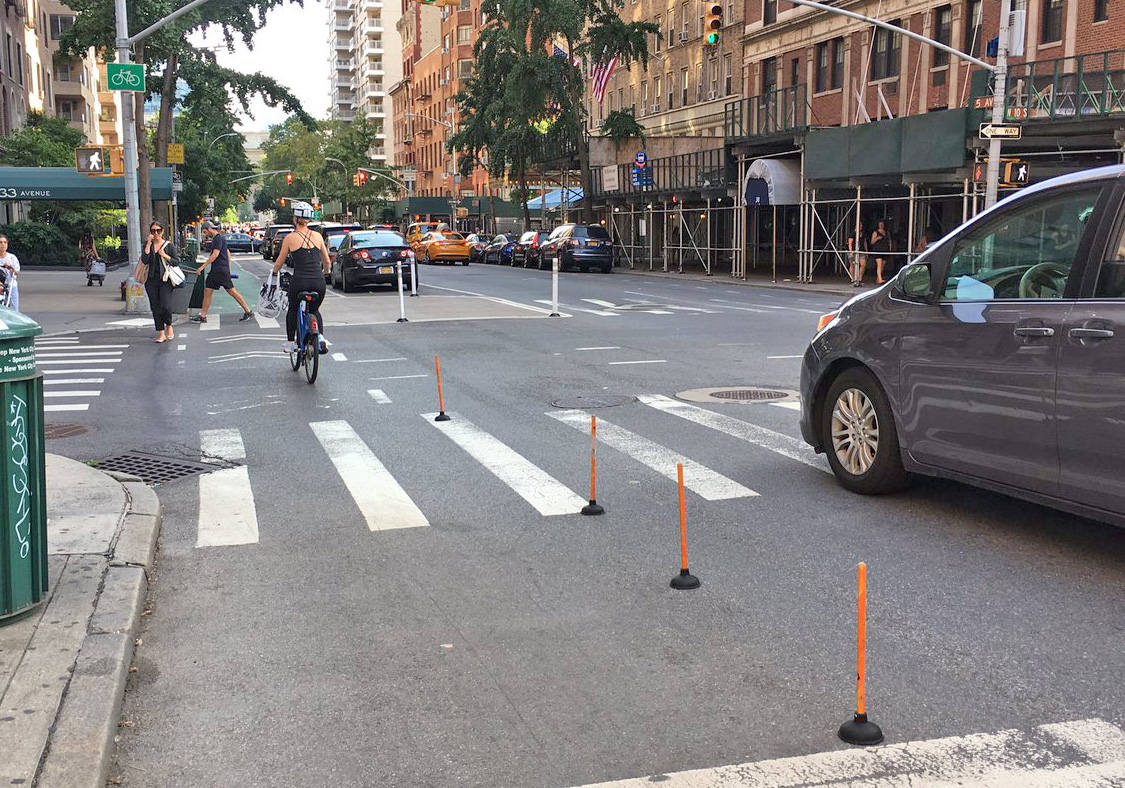It's time to flush mixing zones down the toilet!
Activists "fixed" the city's most controversial and dangerous intersection design in the simplest manner — deploying simple toilet plungers to keep cars out of a "mixing zone" on Fifth Avenue on Tuesday night — in the latest effort to highlight the de Blasio administration's Vision Zero shortcomings and symbolically deposit them in the bathroom fixture evoked.
Mixing zones have been deployed for several years by the city to, theoretically at least, let drivers safely turn through bike lanes and give cyclists space to veer around them, but in practice lead to drivers almost running into cyclists and in some cases killing them. So on Tuesday night, before Transportation Alternatives' die-in in Washington Square Park, members of the Transformation Department deployed some well-placed toilet plungers near 10th Street as a barrier to give cyclists and drivers safe, conflict-free passage.
The activists, who comprise Twitter's best-loved rogue government agency, said they "wanted to show how easy and inexpensive it is to fix this known danger."
Just six of them placed as an extension of the bike lane to separate turning cars from moving cyclists: pic.twitter.com/6SB3VrMdUV
— Transformation Dept. (@NYC_DOTr) July 10, 2019
This bit of tactical urbanism forced drivers to choose: drive over a bunch of stuck up plungers or drive around them, which meant stopping to let a series of cyclists moving up the street go through the intersection first. And as the video evidence shows, the drivers waited and the cyclists took the light (and hey for you prescriptivists out there, don't forget the people going straight through the intersection have the right of way over people turning).
Here’s how it worked: pic.twitter.com/Xrt0WLNHbD
— Transformation Dept. (@NYC_DOTr) July 10, 2019
And one more: pic.twitter.com/VTICAh4VRW
— Transformation Dept. (@NYC_DOTr) July 10, 2019
Look at that! Instead of "balancing" the desire of motorists to get where they're going as fast as possible without any hitch or speed bump, human or otherwise, the more vulnerable road users got where they were going safely.
The good news is that the DOT is moving away from mixing zones along First and Second avenues in Manhattan and Fourth Avenue in Brooklyn, in favor of semi-protected offset crossings. It's a switch that the Transformation Department told us is "a huge improvement," with just one caveat: "The problem is the pace of these improvements," the group said over a DM. "Where they are happening, it’s only as streets get repaved. There’s nothing stopping DOT from moving faster."
Another caveat: Not all drivers know exactly what to do at an offset crossing, as many of them veer too far into the side street on turns, blocking cyclists as they proceed — with the right of way! — straight. And the city's own report — "Cycling at a Crossroads" [PDF] — is very clear that all intersections have shortcomings. One thing is certain: Cyclists say they feel more "comfortable" at offset crossings, the report showed.






